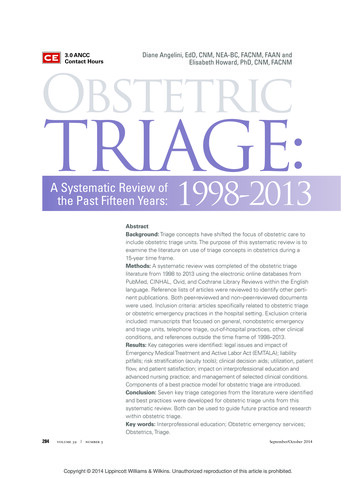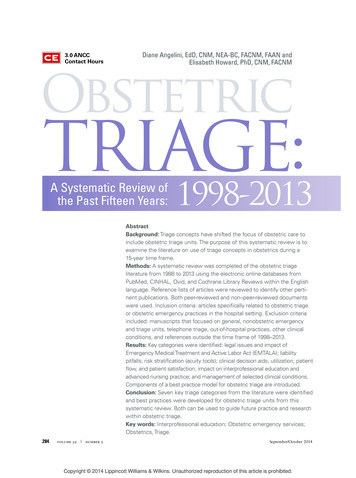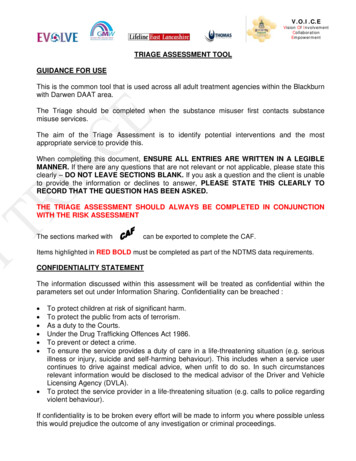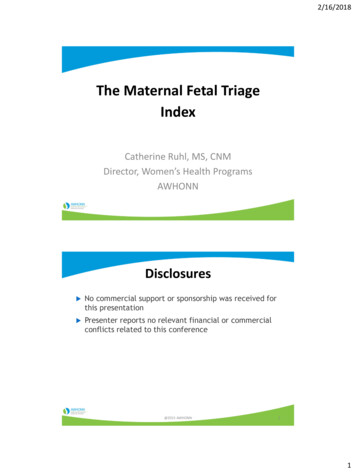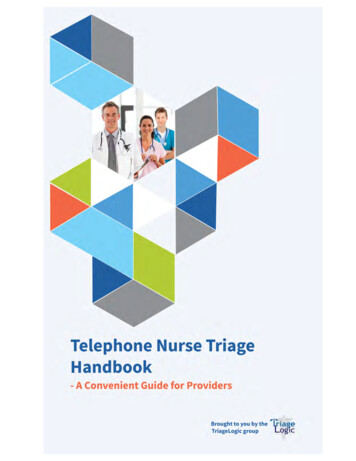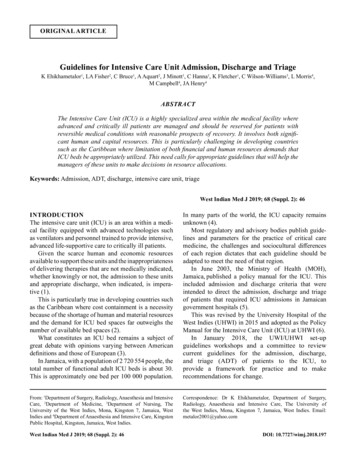
Transcription
GD-097-PHS-EMSTriage, Treatment and TransportGuidelines (T3G)As Recommended by the Bureau of EMS and Trauma SystemArizona Department of Health ServicesUpdated and approved (minus the drug profiles) by MDCSeptember 19, 2019. Clarification edits by Bureau January15, 2020.1
DISCLAIMERThese guidelines are designed to be a resource document for use by Medical Direction Authorities, asdefined by A.R.S. § 36-2205, responsible for the administrative, organizational and on-line medicaldirection of pre-hospital Emergency Medical Care Technicians (EMCTs). It is specifically recognized thatdocumented regional or local variations from the guidelines contained within are not only acceptable,but also appropriate, depending on the individual circumstances of the involved areas andorganizations.By Statute and Rule, all advanced life support pre-hospital EMCTs shall have administrative and on-linemedical direction. These guidelines are not meant to act as a substitute, proxy or alternative to thatmedical direction. Any conflict between these guidelines and the EMCT’s medical direction shall defaultto the Administrative or on-line medical direction.These guidelines are deemed by the Bureau of EMS and Trauma System to be within the acceptablestandard of medical care. It is specifically recognized that there are acceptable documented regional orlocal variations from these procedures and protocols, which may also satisfy the standard of care. Thismanual does NOT define, limit, expand, or otherwise purport to establish the legal standard of care.2
HOW TO USE THESE GUIDELINESThese guidelines have been adapted from the National Association of State EMS Officials (NASEMSO)Model EMS Clinical Guidelines published online in January 2019. These algorithms include specificrecommendations for evaluation and treatment.Inclusion and exclusion patient criteria are listed under the title of each guideline.The recommendations within each guideline are listed in order by provider level scope of practice. It isassumed that more advanced levels of EMCT will perform all recommended evaluations and treatmentsincluded in the preceding level of care.STR stands for Special Training Required. “STR skill” means “Specialty Training Requirement skill,” definedas a medical treatment, procedure, or technique or administration of a medication for which an EMCTneeds specific training per R9-25-502. This includes oversight by administrative and online medicaldirection.The guidelines include specific pediatric recommendations, highlighted by the EMS for Children bear logo,where specific pediatric recommendations differ from those for adults. It is assumed that children willreceive the evaluation and care recommended for all patients, unless specific pediatricrecommendations are included in the algorithm.A pediatric patient is defined as age less than 15 years. Age 15 and above is considered an adult patient inregard to treatment guidelines.The guidelines include specific energy/shock recommendations for cardioversion and defibrillationhighlighted by the lighting bolt symbol.The Universal Care treatment guideline should be applied to all patient encounters, and encompasses bothadult and pediatric patients. All initial patient care is included in this guideline to reduce the need forextensive reiteration of basic assessment and other considerations in every guideline.On-line medical direction may be utilized at any time during the patient encounter per local protocols.The appendix contains additional reference material applicable to these guidelines, such as burnassessment and neurologic assessment tools.The NASEMSO model guidelines include additional information that medical direction authorities may findhelpful for education, training, and quality improvement activities, including patient safety considerations,educational pearls, performance measures, and literature rsion2.2.pdfVersion 2.2 Updated January 5, 2019.“TOC” Table of Contents3
TitleUni versal Ca re: Adult & Pediatric (2 pages)Page6-7TitlePageDo Not Resuscitate (DNR) Status/Advanced Directives/Hea lthcare Power of Attorney (POA) Status: Adult &Pedi atric33Functi onal Needs: Adult & Pediatric8Non-Tra umatic Termination of Resuscitation (TOR)Efforts : Adult & Pediatric34Pa ti ent Refusals: Adult & Pediatric9Tra umatic Ca rdiac Arrest Termination of Resuscitation(TOR) Efforts: Adult & Pediatric35Abus e a nd Ma ltreatment: Adult & Pediatric10Ai rwa y Ma nagement: Adult & Pediatric36Agi ta ted or Vi olent Patient/Behavioral Emergency: Adult &Pedi atric11Pedi atric Respiratory Distress - Wheezing if 2 years old(Bronchiolitis)37Ma na gement of Acute Pain: Adult & Pediatric12Pedi atric Stridor (e.g., Croup)38Syncope and Presyncope: Adult & Pediatric13Pedi atric Brief Resolved Unexplained Event (BRUE)/Pedi atric Apparent Life Threatening Event (ALTE)39Ches t Pain/Acute Coronary Syndrome/ST-segment El evationMyoca rdial Infarction (STEMI): Adult14Neonatal Resuscitation (2 pages)Bra dycardia: Adult & Pediatric15Chi l dbirth42Implantable Ventricular As sist Devices (VAD, LVAD, etc.):Adul t & Pediatric16Obs tetrical/Gynecological Conditions43Ta chyca rdia with a Pulse: Adult & Pediatric17General Tra uma Ma nagement: Adult & Pediatric44Sus pected Stroke/Transient Ischemic Attack: Adult &Pedi atric18Burns : Adult & Pediatric45Bronchospasm (Due to Asthma and Obstructive LungDi s ease): Adult & Pediatric19Externa l Hemorrhage Ma nagement: Adult & Pediatric46Pul monary Edema: Adult & Pediatric20Extremi ty Tra uma: Adult & Pediatric47Ana phylaxis and Allergic Reaction: Adult & Pediatric21Tra umatic Brain Injury (EPIC-TBI): Adult & Pediatric48Al tered Mental Status: Adult & Pediatric22Spi nal Moti on Restriction (SMR): Adult & Pediatric49Hypogl ycemia: Adult & Pediatric23Poi s oning/Overdose Universal Ca re: Adult & Pediatric50Hypergl ycemia: Adult & Pediatric24Acetyl cholinesterase Inhibitor Poisoning (Nerve Agents,Orga nophosphates, a nd Ca rbamates): Adult & Pediatric51Sei zures: Adult & Pediatric25Ra diation Exposure: External and/or InternalConta mination: Adult & Pediatric52Na usea/Vomiting: Adult & Pediatric26Derma l Chemical Burns: Adult & Pediatric53Shock: Adult & Pediatric27Sti mulant Toxicity: Adult & Pediatric54Sepsis: Adult & Pediatric28Sus pected Cya nide Poisoning: Adult & Pediatric55Ca rdi ac Arrest (VF/VT/Asystole/PEA): Age 8 a nd Older29Ca rbon Monoxide/Smoke Inhalation: Adult & Pediatric56Ca rdi ac Arrest (VF/VT/Asystole/PEA): Pediatric Age 830Sul fide Poisoning: Adult & Pediatric57Pos t-Cardiac Arrest and Return of Spontaneous Ci rculation(ROSC) Ca re, Tra nsport to Ca rdiac Receiving Center (CRC):Adul t31Opi oid Poisoning/Overdose: Adult & Pediatric58Obvi ous/Apparent Death: Adult & Pediatric32Next pa ge please40-41
TitlePageBi tes and Envenomations: Adult & Pediatric59Hyperthermia/Heat Exposure: Adult & Pediatric60Drowning: Adult & Pediatric61Conducted Electrical Weapons (TASER) : Adult & Pediatric62Appendix: Abnormal Vi tal Signs63Appendix: Neurologic Status Assessment: Adult & Pediatric (264-65pa ges)Appendix: Prehospital Stroke Scales66Appendix: Guidelines for Field Triage of Injured Patients Uni ted States, 201167Appendix: Burn Tri age a nd Burn Es timation Charts (2 pages)68-69Appendix: Drip Calculations70Appendix: Blood Thinner List71Appendix: ECG Cha nges i n Hyperkalemia72Appendix: Ca rdiocerebral Resuscitation (CCR) /Mi ni mally Interrupted Ca rdiac Resuscitation (MICR)73Appendix: FLACC/CHEOPS74Appendix: AZ Ca rdiac Receivi ng & Referral Centers75Future Appendix: Drug ProfilesTitlePage
Universal Care: Adult & Pediatric (2 pages)6TOCThese general recommendations apply to all patient encounters. Patient care goals are to facilitateappropriate initial assessment and manage treatment of any EMS patient.EMT Assess scene safetyUse appropriate personal protective equipment (PPE)Determine number of patientsDetermine need for formal triage and additionalresources Determine mechanism of injury Determine SMR needs It is preferable for minors to have a parent orlegal guardian who can provide consent fortreatment on behalf of the child; however,EMS providers may provide emergencytreatment when a parent is not available toprovide consent. Use commercially available toolfor weight estimatePrimary Survey (Airway, Breathing, Circulation, Disability, Exposure) Open airway as indicated- Consider position, suction, and use of airway adjuncts as indicated Administer oxygen as appropriate Assess circulatory status- Control any major external bleeding & Initiate chest compressions as indicated Evaluate patient responsiveness: AVPU/GCS Evaluate gross motor and sensory function in all extremities Expose patient as appropriate to the chief complaintSecondary Survey Obtain baseline vital signs Assess blood glucose as indicated OPQRST history SAMPLE history Check temperature as indicated, treat environmental hyperthermia/hypothermiaOngoing Reassessment Proceed to the appropriate guideline as indicated Determine need for transport, resources available, and location of most appropriate destination transport as indicated Reassess chief complaint, assessment findings, and response to treatment Assess vital signs at least every 5 minutes for unstable patients; every 15 minutes for stableAEMT Consider appropriate airway management adjuncts.EtCO2 monitoring should be performed afterplacement of any supraglottic or advanced airway. IV/IO access as indicated Initiate IV fluids as indicated Use commercially available tool formedication dosing and equipment sizeselection.EMT-I/Paramedic Consider appropriate airway management adjuncts, escalate as indicated. 12-lead ECG should be performed early, where available, in patients with suspected cardiac complaints,goal within 5 minutes of patient contact. In patients with cardiac or respiratory complaints:- Continuous cardiac monitoring- Consider waveform capnography (EtCO2) in addition to pulse oximetry (SaO2)
Pediatric Assessment Triangle7TOC
Functional Needs: Adult & Pediatric8TOCIncludes: Patients with physical, sensory, mental health, and cognitive and/or intellectual disabilitiesaffecting their ability to function independently without assistance.EMT Identify the functional need by means of information from the patient, the patient’s family, bystanders,medic alert bracelets or documents, or the patient’s adjunct assistance devices The physical examination should not be intentionally cut short, although the manner in which the examis performed may need to be modified to accommodate the specific needs of the patient Medical care should not intentionally be reduced or abbreviated during the triage, treatment andtransport of patients with functional needs, although the manner in which the care is provided mayneed to be modified to accommodate the specific needs of the patient For patients with communication barriers (language or sensory), it may be desirable to obtain secondaryconfirmation of pertinent data (e.g. allergies) from the patient’s family, interpreters, or written orelectronic medical records. The family members can be an excellent source of information and the presence of a family membercan have a calming influence on some of these patients Transport patients with all assistance adjuncts and service animals if feasibleAEMTEMT-I/Paramedic
Patient Refusals: Adult & PediatricIf an individual (or the parent or legal guardian of the individual) declines or refuses secondary careand/or ambulance transport to a hospital after EMS providers have been called to the scene, providersshould determine the decision maker’s capacity to make medical decisions.Decision-Making CapacityAn individual who is alert, oriented, and has the ability to understand the circumstances surroundinghis/her illness or impairment, as well as the possible risks associated with refusing treatment and/ortransport, typically is considered to have decision-making capacity. Decision-making capacity should bedemonstrated and documented as defined by the presence of all 4 criteria. The patient must be able to: Receive and comprehend information needed to make a decision, Process and deliberate a decision and its potential consequences, Make and articulate a decision that is consistent over time, Justify that decision with logic that fits the individual’s own value system.The individual’s judgement must not be impaired by illness, injury, or clinically apparent drug/alcoholintoxication. GCS score must be normal (15).Individuals who have attempted suicide, verbalized suicidal intent, or who otherwise exhibit indicatorsthat lead EMS providers to reasonably suspect suicidal intent may not decline transport to a receivingfacility. In addition, patients with court order for psychiatric care may not refuse care.EMT EMS providers should make all reasonableefforts to avoid danger to themselves. Obtain a complete set of vital signs. Complete an initial assessment withparticular attention to neurologic andmental status. Perform appropriate medical care withthe consent of the individual. It is preferable for a minor to have a parent orlegal guardian who can provide consent fortreatment on behalf of the minor. However,EMS providers may provide emergencytreatment when a parent is not available toprovide consent. Parent or legal guardian must refuse careon behalf of a minor. Parents may not refuse care if abuse orneglect is suspected. Notify law enforcementas necessary to facilitate transport to thehospital. Emancipated minors must provide stateissued emancipated identification card. Individuals must be advised of the risks and consequences resulting from refusal of medical care. Assess the patient’s understanding of the medical emergency: the possible medical problems, theproposed medical care, the benefits of medical care and risks of refusal. Contact on-line medical direction based on local protocol. Provider must document patient encounter.AEMTEMT-I/Paramedic9TOC
Abuse and Maltreatment: Adult & Pediatric10TOCBe aware of potential clues to abuse/maltreatment from caregivers, the general environment, and the patient’sphysical condition.Recognize any act, or series of acts of commission or omission by a caregiver or person in a position of power overthe patient, that results in harm, potential for harm, or threat of harm to a patient.EMS role is to: Document concerns, Assess and stabilize potentially serious injuries, Disclose concerns to the appropriate authorities (hospital and law enforcement or state authorities). EMS personnel are mandatory reporters of any suspicion for abuse, maltreatment, neglect, or suspected humantrafficking or sex trafficking of a minor per A.R.S. §13-3620.A and A.R.S. §13-3212 Notify the following applicable entities:1. Law enforcement and one of the following:a. Arizona Department of Child Safety (1-888-SOS-CHILD (1-888-767-2445))b. Adult Protective Services Central Intake Unit (1-877-SOS-ADULT s.aspx?form 130042. A tribal law enforcement or social services agency for any Native American minor who resides on anIndian reservationNOTE: Reporting to hospital personnel does not qualify as having fulfilled the mandatory reporting requirement. Leave the investigation to law enforcement.EMT Primary survey– Identify potentially life-threatening issues.– Refer to General Trauma Management as needed.Secondary survey Assess physical issues, document any statements made spontaneously by patient, avoid extensiveinvestigation of the specifics of abuse.Report concerns immediately about caregivers impeding your ability to assess/transport patient or refusing carefor the patient.Attempt to preserve the evidence, but the overriding concern should be providing emergency care to the patient. Scenarios that call for a high index of suspicion forabuse in children include: Brief Resolved Unexplained Event (BRUE) Any bruising on a patient 4 months, or anybruising on the torso, ears, neck on apatient 4 years.
Agitated or Violent Patient/Behavioral Emergency:Adult & PediatricIncludes: patients who are exhibiting agitated, violent, or uncooperative behavior or who are adanger to self or others.Excludes: patients exhibiting agitated or violent behavior due to medical conditions including, but notlimited to: Acute head trauma. Metabolic disorders (e.g. hypoglycemia, hypoxia).EMT Dispatch law enforcement immediately when necessary to secure and maintain scene safety. Do notattempt to enter scene before safety is ensured. Initiate Universal Care. Obtain blood glucose level (if possible). Attempt verbal reassurance and calm patient. Engage family members/loved ones to encourage patient cooperation if their presence does notexacerbate the patient’s agitation. Consider physical restraints:Body:– Sheets can be used in addition to stretcher straps; place around the lower lumbar region, belowbuttocks, or around the thighs, knees and legs.– Do not apply restraints that restrict the patient’s chest wall motion.Extremities:– Soft or leather restraints should not require key.– Restrain all four extremities to stationary frame of stretcher. Place stretcher in sitting position. If in police handcuffs, key must be in ambulance with patient at all times.AEMTEMT-I/Paramedic Apply cardiac monitor as soon as possible,particularly when chemical restraints have beenadministered. Utilize EtCO2 if available for all patients receivingchemical restraints. Consider chemical restraints based uponpatient’s clinical condition; use caution as allthese medications can cause respiratorydepression/compromise. Time intervals forrepeat dosing will vary; refer to specific drugprofile. Benzodiazepines:– Midazolam: 5 mg IM/IN/IV/IOMax total dose 20 mg– Lorazepam: 2-4 mg IM or 2 mg IV/IOMax total dose 4 mg Ketamine (Paramedic only):– 4 mg/kg IM/IN, max initial dose of 250 mg– 2 mg/kg IV/IO, max initial dose 150 mg Chemical restraints should be a laterconsideration for pediatric patients.Call for medical direction. Consider chemical restraints based uponpatient’s clinical condition; use caution as allthese medications can cause respiratorydepression/compromise. Time intervals forrepeat dosing will vary; refer to specific drugprofile. Benzodiazepines: Midazolam: 0.1-0.15 mg/kg IM or 0.05-0.1mg/kg IV/IO or 0.3 mg/kg IN. Max initialdose 5 mg Lorazepam: 0.05 mg/kg IM/IV/IO. Max initialdose 2 mg IV/IO and 4 mg IM11TOC
Management of Acute Pain: Adult & Pediatric12TOCAssess pain as part of general patient care in children and adults. Consider all patients as candidates formanagement of acute pain, regardless of transport interval.Caution: Multi-system trauma patients.Excludes: Hypotension for age SaO2 90% Hypoventilation Allergy to morphine or fentanyl Active laborEMT Initiate Universal Care. Use an age-appropriate pain scale to assess pain,such as Numeric Rating Scale. If available, consider use of non-pharmaceuticalpain management techniques: Place patient in position of comfort, whileadhering to safe transport recommendations. Apply ice packs and/or splints. Verbal reassurance (will lower anxiety). Apply a pulse oximeter and administer oxygen asneeded to maintain SaO2 94%.Use an age-appropriate pain scale to assess pain: Age 4 years: Consider using an observationalscale such as FLACC (face, legs, activity, cryconsolability) or CHEOPS (Children’s Hospital ofEastern Ontario Pain Scale). Age 4-12 years: Consider using a self-report scalesuch as Faces Pain Scale-revised or Wong-BakerFaces. Age 12 years: Consider using a self report scalesuch as Numeric Rating Scale.AEMT Morphine: 0.1 mg/kg/dose IV/IO, max 2-5 mg increments, max total dose 15 mg.Reassess pain every 5 minutes.Evidence of serious adverse effects should preclude further morphine administration.If still in significant pain, re-dose at the original dose.Additional analgesics per local protocol.Reassess pain every 5 minutes, observe for adverse effects, and re-dose as above.EMT-I/Paramedic Fentanyl: 1 mcg/kg/dose IN/IV/IO, max initialdose 100 mcg, max total dose 200 mcg. Ketamine (Paramedic only): 0.25 mg/kg IV/IO,max per dose 25 mg, max total dose 100 mg. Consider intranasal route for medication ifavailable. Fentanyl: 1 mcg/kg/dose IN/IV/IO, maxinitial dose 100 mcg, max total dose200 mcg.
Syncope and Presyncope: Adult & PediatricIncludes: patients presenting with both abrupt loss of consciousness and loss of postural tone.Presyncope or prodromal symptoms may be described as “nearly blacking out” or “nearlyfainting” and should be considered to have the same or similar risk for significant illness as anypatient who has lost consciousness.Excludes: Patients with trauma – refer to Traumatic Brain Injury (EPIC-TBI). Patients with ongoing mental status changes or coma should be treated per the Altered Mental Status. Evidence of other alternate etiology. Refer to appropriate guideline: Seizures, Suspected Stroke,Hypoglycemia.EMT Initiate Universal Care. Assess blood glucose, refer to Hypoglycemia as indicated.AEMT If symptoms of poor perfusion, give 500 mLIV/IO fluid bolus, and repeat as necessary. Max30 ml/kg. Titrate to SBP 90. Refer to Shock as needed. If symptoms of poor perfusion, give 20 mL/kgIV/IO fluid bolus, repeat as needed. Titrate toage appropriate SBP (Abnormal Vital Signs)using push-pull methods. Refer to Shock as needed.EMT-I/Paramedic Place on cardiac monitor – treat arrhythmias if present. Bradycardia Tachycardia with a Pulse Cardiac Arrest (VF/VT/Asystole/PEA): Age 8 and Older or Cardiac Arrest (VF/VT/Asystole/PEA):Pediatric Age 8 Perform 12-lead ECG.13TOC
Chest Pain/Acute Coronary Syndrome/ST-segmentElevation Myocardial Infarction (STEMI): AdultIncludes: patients with non traumatic chest pain or anginal equivalents. This includes discomfort in thearm, jaw, or epigastric region of suspected cardiac origin, shortness of breath, sweating, nausea, vomiting,and dizziness. Atypical or unusual symptoms are more common in women, the elderly and diabeticpatients. Patients may also present with CHF, syncope, and/or shock.Caution: do not give Nitroglycerin to any patient who has taken PDE5-inhibitor medication (sildenafil,tadalafil) for erectile dysfunction or pulmonary hypertension within 24-48 hours.EMT Initiate Universal Care. If short of breath, hypoxic, or with obvious signs of heart failure, administer oxygen and titrate to SaO2of 94% Administer Aspirin 325 mg PO or 325 mg chewed. Assist patient in self-administration of Nitroglycerin 0.4 mg tablets or spray if prescribed to patient andSBP 100 mm Hg. Repeat every 3-5 minutes x 2, until pain resolves, as blood pressure allows. Contraindicated with erectile dysfunction medication (sildenafil, tadalafil) within 24-48 hours.AEMT Administer Nitroglycerin 0.4 mg SL tablets or 1 full spray if SBP 100 mm Hg. May repeat every 3-5 minutes x 2, until pain resolves, as blood pressure allows. Contraindicated with erectile dysfunction medication within 24-48 hours. For STEMI only: consider treating chest pain unresponsive to nitrates. Morphine 0.05 mg/kg/dose IV, max of single dose of 3 mg. May repeat in 10 minutes to a total maxof 10 mg if pain unresolved, if blood pressure allows. Morphine should be used with caution in unstable angina/non-STEMI due to an association withincreased mortality.EMT-I/Paramedic Additional treatment option for STEMI chest pain unresponsive to nitrates: Fentanyl 0.5 mcg/kg/dose IN/IV/IO, max total dose 200 mcg. Obtain 12 lead ECG and transmit, goal within 5 minutes of patient contact. Use caution administering nitroglycerin to patients that demonstrate inferior STEMI patterns(STE in II, II, aVF). Transport patient to Cardiac Receiving or Referral Center per local protocol or procedure Notify receiving facility immediately for STEMI. Transmit 12 lead ECG to receiving facility if possible. Performance of serial ECGs is recommended if not diagnostic or change in patient condition.14TOC
Bradycardia: Adult & PediatricIncludes: Heart rate 60 with either symptoms (altered mental status, chest pain, congestive heartfailure, seizure, syncope, shock, pallor, diaphoresis) or evidence of hemodynamic instability.EMT Initiate Universal Care. For age 6 months and heart rate 60 andsigns of poor perfusion, initiate chestcompressions and refer to Cardiac Arrest(VF/VT/Asystole/PEA): Pediatric Age 8.AEMT If signs of poor perfusion, give 500 mL IV/IOfluid bolus (unless signs of fluid overload). Mayrepeat to maximum of 30 ml/kg. If signs of poor perfusion, give 20 mL/kg IV/IOfluid bolus (unless signs of fluid overload). Mayrepeat as needed to a max 60 mL/kg.EMT-I/Paramedic Place on cardiac monitor. Perform 12-lead ECG. If bradycardia and symptoms of hemodynamicinstability continue, consider the following: Atropine Sulfate: 0.5 mg IV/IO every 3-5min, max total dose 3 mg. Epinephrine:o Drip 0.02 - 0.2 mcg/kg/min.o Push Dose *** 10-20 mcg boluses (1-2mL) every 2 minutes. If bradycardia and symptoms orhemodynamic instability continue, considerthe following: Epinephrine***: Push 1 mcg/kg (0.1mL/kg), max single dose 10 mcg (1 mL)every 3-5 minutes. Atropine Sulfate: 0.02 mg/kg IV/IO (mindose 0.1 mg), max initial dose 0.5 mg, maxtotal dose 3 mg.*** Push dose epinephrine preparation: mix 1 mL of 0.1 mg/mL epinephrine with 9 mL of NS. This resultsin 10 mcg/mL concentration. If bradycardia and symptoms of hemodynamic instability continue, consider transcutaneous pacing. If pacing is performed, consider sedation or pain control per Management of Acute Pain. Utilize EtCO2 if available for all patients receiving sedation. Sedation (if age 60 consider reducing dose byhalf): Midazolam: 1 mg IV slowly every 2-3minutes, max dose 5 mg. Lorazepam: 1 mg IV every 5-10 minutes,max dose 4 mg. Sedation: Midazolam: 0.1 mg/kg IV slowly, every 2-3minutes, max dose 5 mg. Lorazepam: 0.1 mg/kg IV every 10 minutes,max dose 4 mg.15TOC
Implantable Ventricular Assist Devices (VAD, LVAD, etc.): Adult &PediatricIncludes: patients that have had an implantable ventricular assist device (VAD), including a left ventricularassist device (LVAD), right ventricular assist device (RVAD), or biventricular assist device (BiVAD).EMT Initiate Universal Care. BP measurement will require manual cuff and doppler to obtain mean arterial pressure (MAP),assess patient for signs of hypoperfusion, pallor, altered LOC. Pulse is variable and not clinically significant in VAD patients. Pulse oximetry can be unreliable – look for physical signs and symptoms . Contact the patient’s VAD program on-call coordinator using the phone number on the device;follow coordinator’s advice. Banner University Phoenix VAD -----602-819-7910 Banner University Tucson VAD ------ 520-694-6000 Dignity St. Joseph’s VAD--------------- 602-406-8000 Mayo VAD --------------------------------- 480-342-2999 Decision to perform CPR should be made in consultation with patient’s VAD-trained companionand VAD coordinator. CPR may be initiated only where: Confirmation that the pump has stopped and troubleshooting efforts have failed, and Patient is unresponsive and has no detectable signs of life. Assess for alarms.Assess for possible pump malfunction – mechanical hum should be present on auscultation.Contact the patient’s VAD-trained companion, if available.Check all the connections to system controller, change VAD batteries, and/or change system controllerif indicated. Follow appropriate cardiovascular condition-specific protocol(s) as indicated. If patient is experiencing VAD-related complications or cardiovascular problems, transportdestination preference is his/her VAD program, nearest VAD-trained facility, nearest appropriatefacility.AEMT Establish IV/IO. If patient has a functioning VAD and is hypoperfusing (pale, diaphoretic, delayed capillary refill,altered mental status), administer 30 mL/kg IV/IO fluid bolus, maximum 1 L, over 15 minutes,using push-pull method. May repeat up to 3 times based on patient’s condition and clinical impression. Do not administer nitroglycerin.EMT-I/Paramedic Apply cardiac monitor. Acquire 12-lead EKG. Patient’s baseline may be arrhythmia; obtain VAD coordinator’s advice prior to administeringantiarrhythmics.16TOC
Tachycardia with a Pulse: Adult & Pediatric17TOCIncludes: Elevated heart rate for age, with or without associated symptoms such as palpitations, dyspnea,chest pain, syncope/near-syncope, hemodynamic compromise, altered mental status or other signs of endorgan malperfusion. Adults: HR 100.Excludes: sinus tachycardia. Rate-related symptoms are uncommon when heart rate 150.EMT Initiate Universal Care. Search for underlying causes (medications, drugs, history of dysrhythmia, CHF, etc.)AEMTEMT-I/ParamedicAll Unstable tachycardias Deliver a synchronized cardioversion.Consider the following if stable symptomatic tachycardia (ifknown WPW contact on-line medical direction):Stable SVT Perform vagal maneuvers. Adenosine: 6 mg IV/IO. If tachycardia continues, give 12 mg IV. Always follow with 10 mL fluid bolus. Diltiazem: (Paramedic only) 0.25 mg/kg IV/IO. Give half of dose slowly over 2 minutes. May give remainder of dose in 10 minutes as neededand as blood pressure allows. Patients 65 years old, max initial dose 10 mg.Irregular narrow complex tachycardia (A-fib, A-flutter,multifocal atrial tachycardia), Stable Diltiazem: (Paramedic only) 0.25 mg/kg IV/IO Give half of dose slowly over 2 minutes. May give remainder of dose in 10 minutes as neededand as blood pressure allows. Patients 65 years old, max initial dose 10 mg.Regular wide complex tachycardia, Stable Adenosine: 6 mg IV/IO. If tachycardia continues, give 12 mg IV. Always follow with 10 mL fluid bolus.
DISCLAIMER . These guidelines are designed to be a resource document for use by Medical Direction Authorities, as defined by A.R.S. § 36-2205, responsible for the administrative, organizational and on- line medical
